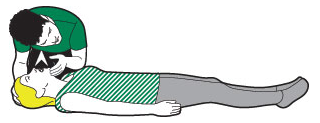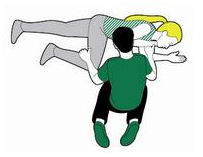Dealing with an adult who is unresponsive
Peer reviewed by Dr Doug McKechnie, MRCGPLast updated by Dr Colin Tidy, MRCGPLast updated 31 Oct 2023
Meets Patient’s editorial guidelines
- DownloadDownload
- Share
- Language
- Discussion
In this series:Breathlessness and difficulty breathingPulmonary embolismPulmonary fibrosisControlled breathing
This leaflet is created from first aid advice provided by St John Ambulance, the nation's leading first aid charity.
If someone becomes unresponsive they need someone to help keep them safe and prevent further harm. The type of help they need varies depending on why they have become unresponsive, whether they are breathing or not breathing and if they are baby, child or adult.
In this article:
This leaflet is designed to give a summary of general advice. This advice is no substitute for first aid training (see 'Further Reading' below to find out more about St John Ambulance and British Red Cross training courses).
Continue reading below
If someone is unresponsive and breathing
What to look for
If someone is not responding to you and you think they are unresponsive, ask loudly: 'Are you alright?' or 'Open your eyes'. If they don't respond, pinch their earlobe or gently shake their shoulders. If they still don't respond, then you can presume they're unresponsive.
What you need to do
Step 1 of 5: Open the airway
Place one hand on the person's forehead and gently tilt their head back. As you do this, the mouth will fall open slightly.
Place the fingertips of your other hand on the point of the person's chin and lift the chin.
Open the airway

Step 2 of 5: Check breathing
Look, listen and feel for normal breathing - chest movement, sounds and breaths on your cheek. Do this for no more than ten seconds.
Check breathing

Step 3 of 5: Put them in the recovery position
This will keep their airway open.
Kneel down next to them on the floor.
The next three steps are for if you find the person lying on their back. If you find them lying on their side or their front you may not need all three.
Place their arm nearest you at a right angle to their body, with their palm facing upwards.
Take their other arm and place it across their chest so the back of their hand is against their cheek nearest you, and hold it there. With your other hand, lift their far knee and pull it up until their foot is flat on the floor.
Now you're ready to roll them on to their side. Carefully pull on their bent knee and roll them towards you. Once you've done this, the top arm should be supporting the head and the bent leg should be on the floor to stop them from rolling over too far.
Recovery position

Step 4 of 5: If you suspect spinal injury
If you think the person could have a spinal injury, you must keep their neck as still as possible. Instead of tilting their neck, use the jaw thrust technique: place your hands on either side of their face and with your fingertips gently lift the jaw to open the airway, avoiding any movement of their neck.
Suspect spinal injury

Step 5 of 5: Call for help
Once you've put them safely into the recovery position, call 999 or 112 for medical help.
Until help arrives, keep checking the person's breathing.
If they stop breathing at any point, call 999 or 112 straightaway and get ready to give them CPR (cardiopulmonary resuscitation - a combination of chest pressure and rescue breaths).
If someone is unresponsive and not breathing
If an adult is unresponsive and not breathing, you'll need to do cardiopulmonary resuscitation (CPR).
CPR involves giving someone a combination of chest compressions and rescue breaths to keep their heart and circulation going to try to save their life. If they start breathing normally again, stop CPR and put them in the recovery position.
What you need to do
If someone is with you, get them to call 999 or 112 for emergency help and ask them to get an automated external defibrillator (AED) if one is available.
How to perform CPR on an adult
Step 1: Giving chest compressions
Kneel down beside the person on the floor, level with their chest.
Place the heel of one hand towards the end of their breastbone, in the centre of their chest.
CPR finger position adult

CPR adult

Place the heel of your other hand on top of the first hand and interlock your fingers, making sure you keep the fingers off the ribs.
Lean over the person, with your arms straight, pressing down vertically on the breastbone, and press the chest down by 5-6 cm (2-2½ in).
Release the pressure without removing your hands from their chest. Allow the chest to come back up fully - this is one compression.
Repeat 30 times, at a rate of about twice a second or the speed of the song 'Staying Alive'.
Give two rescue breaths.
Step 2: Giving rescue breaths
Ensure the person's airway is open.
Open the airway

Pinch their nose firmly closed.
Pinch nose adult

Take a deep breath and seal your lips around their mouth.
Blow into the mouth until the chest rises.
Rescue breath adult

Remove your mouth and allow the chest to fall.
Rescue breath pause adult

Repeat once more.
Carry on giving 30 chest compressions followed by two rescue breaths for as long as you can, or until help arrives.
If an automated external defibrillator (AED) arrives switch it on and follow the instructions provided with it.
If the person starts breathing normally again, stop CPR and put them in the recovery position.
Recovery position

Patient picks for First aid

Treatment and medication
Dealing with a child who is unresponsive
If someone becomes unresponsive they need someone to help keep them safe and prevent further harm. The type of help they need varies depending on why they have become unresponsive, whether they are breathing or not breathing and if they are a baby, child or adult.
by Dr Philippa Vincent, MRCGP

Treatment and medication
Cuts
This leaflet gives a guide as to what you should do following a cut.
by Dr Doug McKechnie, MRCGP
Further reading and references
- St John Ambulance Training Courses
- Red Cross Training Couress
- Unresponsive and not breathing - adults; St John Ambulance
- 2021 Adult advanced life support Guidelines; Resuscitation Council UK
Continue reading below
Article history
The information on this page is written and peer reviewed by qualified clinicians.
Next review due: 29 Oct 2028
31 Oct 2023 | Latest version

Ask, share, connect.
Browse discussions, ask questions, and share experiences across hundreds of health topics.

Feeling unwell?
Assess your symptoms online for free
Sign up to the Patient newsletter
Your weekly dose of clear, trustworthy health advice - written to help you feel informed, confident and in control.
By subscribing you accept our Privacy Policy. You can unsubscribe at any time. We never sell your data.